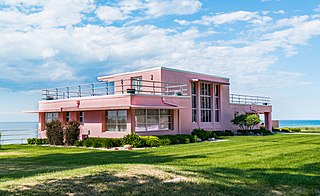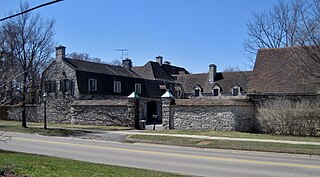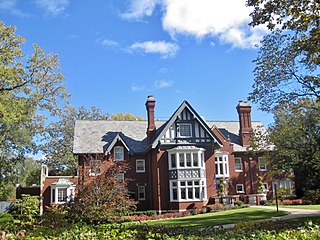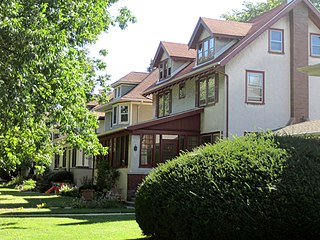
Pittsford is a village in Monroe County, New York, United States. The population was 1,355 at the 2010 census. It is named after Pittsford, Vermont, the native town of a founding father. This is the oldest village in New York, incorporated in 1827. The village, an Erie Canal community, is in the town of Pittsford. Pittsford is a suburb of Rochester, New York.

The Sycamore Historic District is a meandering area encompassing 99 acres (400,000 m2) of the land in and around the downtown of the DeKalb County, Illinois county seat, Sycamore. The area includes historic buildings and a number of historical and Victorian homes. Some significant structures are among those located within the Historic District including the DeKalb County Courthouse and the Sycamore Public Library. The district has been listed on the National Register of Historic Places since May 2, 1978.

The Century of Progress Architectural District is a historic district in Beverly Shores, Indiana. The district is on Lake Shore Drive within the Indiana Dunes National Park. The district comprises five buildings, all from the Homes of Tomorrow Exhibition of the 1933 Century of Progress World's Fair which took place in Chicago. Intended to display the future of housing, the Century of Progress Homes reflect a variety of designs, experimental materials and new technologies. On June 30, 1986, the district was listed on the National Register of Historic Places as the Beverly Shores–Century of Progress Architectural District.
The Cherryfield Historic District encompasses the historic village center of Cherryfield, Maine. This area is distinctive for its collection of high-quality 19th century architecture, which is unique in rural contexts in the state. The district was listed on the National Register of Historic Places in 1990.

The Rochelle Park–Rochelle Heights Historic District is a historic residential district located in the city of New Rochelle in Westchester, New York. The district is historically and architecturally significant as an intact and distinctive example of residential park development at the turn of the Twentieth Century. It includes the historic Rochelle Park development, and the later Rochelle Heights subdivision. Within the district are 555 contributing properties, including 513 buildings, 38 structures, and 4 sites. Only 24 buildings and 1 site separately identified within its area are non-contributing. It was listed on the National Register of Historic Places (NRHP) on July 6, 2005.

The West Line Historic District is a residential community in central Austin, Texas, United States. The district encompasses an approximately 90-block tract of land located west of downtown. Bounded by Baylor Street to the east, Fifth Street to the south, Thirteenth Street to the north and Texas State Highway Loop 1 to the west. It is located south of the Old West Austin Historic District and southeast of the Clarksville Historic District.

The Central Vinton Residential Historic District is a nationally recognized historic district located in Vinton, Iowa, United States. It was listed on the National Register of Historic Places in 2012. At the time of its nomination it contained 266 resources, which included 184 contributing buildings, one contributing structure, and 81 non-contributing buildings. Most of the contributing buildings are houses, and outbuildings. Second Avenue retains its brick paving and it is the contributing structure. Vinton is the county seat of Benton County, and this is one of its most affluent neighborhoods. Because the town is a center of commerce and government, it started to grow in the mid-to-late-nineteenth century.

The Woman's Club of Evanston is a historic house in Evanston, Illinois and is the headquarters for the social club of the same name. It is located at 1702 Chicago Avenue. On November 9, 2006, the clubhouse was added to the National Register of Historic Places.

The Pearl Street Historic District of Burlington, Vermont encompasses part of the city's first major east-west transportation arteries, which developed from a fashionable residential area in the early 19th century to its present mixed use. It contains one of the city's highest concentrations of early Federal period architecture, as well as a number of fine Queen Anne and Colonial Revival houses. It was listed on the National Register of Historic Places in 1984.

The Stuart Area Historic District is a primarily residential historic district in Kalamazoo, Michigan, roughly bounded by the Michigan Central Railroad, Douglas, Forbes, West Main, North, and Elm Streets, and Kalamazoo and Grand Avenues. The bulk of the district was listed on the National Register of Historic Places in 1983, with additions in 1995.

The Sheffield Historic District is a national historic district in the Lincoln Park neighborhood of Chicago, Illinois. The district is primarily a residential area, though it also includes multiple small commercial areas. The area takes its name from Joseph Sheffield, who established an area for farmers to bring livestock and produce to prepare for shipping on Chicago, Rock Island railroad founded by Jospeh Sheffield a New Haven, Connecticut resident at the site in the late 1840’s. Residential development in the area began in 1868, as European immigrants created a demand for new housing, and continued through the 1900s. The district includes examples of many of the most popular architectural styles of the late nineteenth century, with the Queen Anne and Romanesque Revival styles being especially well-represented.

The Buena Park Historic District is a residential historic district in the Uptown neighborhood of Chicago, Illinois. First developed in the 1890s, the district was originally planned to be an upper-class suburban neighborhood of Chicago with spacious homes. Development in the early twentieth century made the neighborhood denser, and while it was still a wealthy neighborhood by 1930, it featured many apartment buildings as well. The district's houses reflect Chicago's architectural development at the turn of the century; while its nineteenth-century homes have Queen Anne and Romanesque Revival designs, its twentieth-century houses exhibit newly popular styles such as the Prairie School and Classical Revival. The district's apartment buildings were designed in part to match the character of its houses, as doing so portrayed a sense of luxury and domesticity to its affluent residents; as a result, they largely used the same styles as the twentieth-century homes and often included courtyards to replace lawns.

Castlewood Terrace is a block-long street and residential historic district in the Uptown neighborhood of Chicago, Illinois. The district includes 26 single-family houses built between 1897 and 1927. The street is highly unusual compared to its surroundings, as both Uptown and Chicago's lakeshore in general were built up with high-rise apartments in the early twentieth century; Castlewood Terrace residents resisted high-rise construction for decades after the street's development. Most of the houses are two to three story brick structures with spacious lots and front driveways, giving the street visual consistency despite the many different architectural styles used in its homes. Some of these architectural styles include Tudor Revival, Renaissance Revival, Foursquare, Colonial Revival, and Queen Anne.

The Lumpkin Heights and Elm Ridge Subdivision Historic District is a residential historic district in Mattoon, Illinois. The district encompasses the Lumpkin Heights and Elm Ridge Subdivision neighborhoods in eastern Mattoon. Lumpkin Heights was originally developed as Lafayette Heights in the late nineteenth and early twentieth centuries, and it only became known by its current name after further development in the mid-twentieth century. The Elm Ridge Subdivision was developed entirely within the mid-twentieth century. The original Lafayette Heights section of the district includes examples of many popular architectural styles from the time of its development, with several examples of Colonial Revival, Tudor Revival, and American Craftsman designs. The remainder of the district exhibits trends common in post-World War II residential development, including several Modernist designs, Ranch-style houses, and prefabricated homes.

The Green Bay Road Historic District is a residential historic district in Lake Forest, Illinois. Centered on Green Bay Road, a historic postal and military road that once connected Chicago with Green Bay, Wisconsin, the district includes 147 contributing buildings. The houses in the district are mainly country estates built in the late nineteenth and early twentieth century for some of the Chicago area's wealthiest residents. The Onwentsia Club, a country club to which most of the district's residents belonged, was the center of the area's social life and is also part of the district. The district includes works by several prominent Chicago architects, including Howard Van Doren Shaw, David Adler, Ambrose Coghill Cramer, and Chester Howe Walcott. While the Arts and Crafts style preferred by Shaw is common in the district, most of the other houses are designed in revival styles, including Classical Revival, Renaissance Revival, Colonial Revival, and Tudor Revival.

The Evanston Ridge Historic District is a residential historic district in Evanston, Illinois. The district is situated along a glacial ridge that was the site of the first white settlement in Evanston in the 1830s. As the development of Evanston accelerated in the mid-nineteenth century, the ridge became a desirable location for new residents, and the growth of Northwestern University and new rail links to Chicago continued to spur development into the twentieth century. As a result, the houses in the district were built over the course of several decades, with most built between 1860 and 1930. Wealthy Chicagoans were particularly drawn to the area, and its homes frequently had formal architectural designs. The Italianate, Queen Anne, and Prairie School styles are all particularly common in the district.

The Northeast Evanston Historic District is a residential historic district in northeastern Evanston, Illinois. The district includes 474 contributing buildings in an area bounded by Sheridan Place to the north, Lake Michigan to the east, Emerson Street to the south, and Ridge Avenue and the CTA's Purple Line to the west. The area was developed later than central and southeast Evanston; while its oldest building dates from the 1860s, most of the homes in the district were built between 1890 and 1930. The district's houses are representative of the popular architectural styles of the period; the American Craftsman, Tudor Revival, and Colonial Revival styles are especially prevalent. Works by many prominent Chicago architects, including Holabird & Roche, Tallmadge & Watson, Howard Van Doren Shaw, George W. Maher, William Carbys Zimmerman, Solon Spencer Beman, and Schmidt, Garden and Martin, can be found in the district. Vernacular works with bungalow, American Foursquare, and gable front designs are also common in the district.

The Oakton Historic District is a residential historic district in south central Evanston, Illinois. The district includes 203 contributing buildings, most of which were developed between 1913 and 1940. Development on Evanston's lakeshore began in the mid-nineteenth century, but the land that became the district was part of a large farm owned by the Mulford family at the time; once the family had sold most of its land, the area was platted in 1890. Most of the residences in the district are single-family houses, a product of Evanston's early zoning laws. The houses reflect the popular architectural trends of the early twentieth century; the Tudor Revival, Colonial Revival, and American Craftsman styles are most common.

The Ouilmette North Historic District is a residential historic district in northeastern Wilmette, Illinois. The district includes 911 contributing buildings; all are houses except for two churches, Trinity United Methodist Church and the Community Church of Wilmette. The southern half of the district was originally part of the Ouilmette Reservation, an Indian reservation which was sold to developers and became the original village of Wilmette in 1872. Development in the district began after the village's incorporation and continued through World War II, with most new construction happening in the early twentieth century. The district includes examples of Queen Anne architecture from the late nineteenth century, Prairie School architecture from the first two decades of the twentieth century, and revival style architecture from the 1920s. Its Prairie School architecture is especially notable as it contains works by William Eugene Drummond and John S. Van Bergen, two early Prairie School architects who practiced with Frank Lloyd Wright.

The Gunderson Historic District is a residential historic district in southern Oak Park, Illinois. The district encompasses 230 residential buildings built between 1906 and 1920, the vast majority of which are single-family homes. The development was the second of two built in Oak Park by S.T. Gunderson and Sons, a housing company which mainly worked in Oak Park and the West Side of Chicago. The firm commissioned architect Frank DeMoney to design their Oak Park houses; most of his designs used the American Foursquare style, a simple style which could be executed affordably. DeMoney differentiated the houses by applying elements of other contemporary architectural styles, such as Arts and Crafts, Colonial Revival, or Prairie School. The uniform design and layout of its homes made the district an early example of tract housing, which would become much more widespread later in the twentieth century.






















